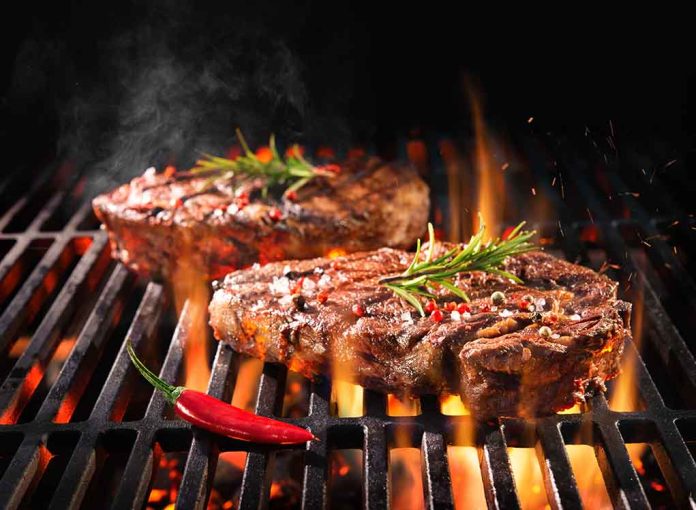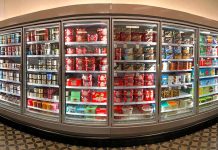Smoking Meat and Poultry
Where there’s smoke, there’s well-flavored meat and poultry. Using a smoker is one method of imparting natural smoke flavor to large cuts of meat, whole poultry, and turkey breasts. This slow cooking technique keeps them tender, too.
What is smoking?
Smoking is slowly cooking food indirectly over a fire. This can be done by using a “smoker,” which is an outdoor cooker especially designed for this purpose. A covered grill can also be used for smoking food by placing a drip pan of water beneath the meat on the grill.
Thaw Meat Before Smoking
Completely thaw meat or poultry before smoking. Because smoking uses low temperatures to cook food, the meat will take too long to thaw in the smoker, allowing it to linger in the “Danger Zone” (temperatures between 40 and 140 °F) where harmful bacteria can multiply. Defrosted meat also cooks more evenly.
Never thaw food at room temperature. Keeping meat and poultry cold while it is thawing is essential to prevent the growth of harmful bacteria. The best way to safely thaw meat and poultry is in the refrigerator. Cook or refreeze it within 1 or 2 days.
The microwave oven can be used to thaw more rapidly. Smoke the meat immediately because some areas of the meat can begin to cook during the thawing process.
Food may also be thawed in cold water. Be sure that the sink or container that holds food is clean before submerging food. Two methods may be used when thawing:
- Completely submerge airtight wrapped package. Change water every 30 minutes.
- Completely submerge airtight wrapped food in constantly running cold water. If thawed completely, it must be cooked immediately.
Marinate in the Refrigerator
Some recipes advise marinating meat and poultry for several hours or days, either to tenderize or add flavor. Acid in the marinade breaks down connective tissue in meats.
Always marinate food in the refrigerator, not on the counter. If some of the marinade is to be used for basting during smoking or as a sauce on the cooked food, reserve a portion of the marinade. Don’t put raw meat or poultry in it. Don’t reuse the marinade from raw meat or poultry on cooked food unless it’s boiled first to destroy any harmful bacteria.
Partial Cooking
Some people like to cook food partially in the microwave oven or on the stove to reduce smoking time. Partially cook meat or poultry ahead of time only if the food goes immediately from the microwave or stove to the hot smoker. Partial cooking of food ahead of time allows harmful bacteria to survive and multiply to the point that subsequent cooking cannot destroy them. And once food is in the smoker, cook until it reaches a safe temperature as determined with a food thermometer.
Using a Smoker
Cook food in smokers made of materials approved for contact with meat and poultry. Don’t smoke foods in makeshift containers such as galvanized steel cans or other materials not intended for cooking. Chemical residue contamination can result.
When using a charcoal-fired smoker, buy commercial charcoal briquettes or aromatic wood chips. Set the smoker in a well-lit, well-ventilated area away from trees, shrubbery, and buildings. Only use approved fire starters — never gasoline or paint thinner, for example.
Follow the manufacturer’s directions for igniting charcoal or preheating a gas or electric outdoor cooker. Let the charcoal get red hot with gray ash — about 10 to 20 minutes depending upon the quantity. Pile the charcoal around the drip pan and fill it with water to maintain a moist environment. The drip pan catches any fat or juice from the meat or poultry and prevents it from flaming up on the coals. Add about 15 briquettes every hour and check to make sure the drip pan contains water. The most satisfactory smoke flavor is obtained by using hickory, apple, or maple wood chips or flakes. Soak the chips in water to prevent flare-ups and add about 1/2 cup of chips to the charcoal as desired.
Using a Covered Grill
To smoke meat and poultry in a covered grill, pile about 50 briquettes in the center of the heat grate. When they are covered with gray ash, push them into two piles. Center a pan of water between the two piles and place the food on the grill over the water pan. The water prevents flare-ups that occur when fat and meat liquids drip on coals, and steam from the water helps destroy harmful bacteria that can cause foodborne illness. Close the lid and keep the grill vents open. Add about 10 briquettes every hour to maintain the temperature in the grill.
Use Two Thermometers to Smoke Food Safely
To ensure meat and poultry are smoked safely, you’ll need two types of thermometers: one for the food and one for the smoker. A thermometer is needed to monitor the air temperature in the smoker or grill to be sure the heat stays between 225 and 300 °F throughout the cooking process. Many smokers have built-in thermometers.
Use a food thermometer to determine the temperature of the meat or poultry. Oven-safe thermometers can be inserted in the meat and remain there during smoking. Use an instant-read thermometer after the meat is taken out of the smoker.
Cooking time depends on many factors: the type of meat, its size and shape, the distance of food from the heat, the temperature of the coals, and the weather. It can take anywhere from 4 to 8 hours to smoke meat or poultry, so it’s imperative to use thermometers to monitor temperatures.
Smoke food to a safe minimal internal temperature.
- Cook all raw beef, pork, lamb and veal steaks, chops, and roasts to a minimum internal temperature of 145 °F as measured with a food thermometer before removing meat from the heat source. For safety and quality, allow meat to rest for at least three minutes before carving or consuming. For reasons of personal preference, consumers may choose to cook meat to higher temperatures.
- Cook all raw ground beef, pork, lamb, and veal to an internal temperature of 160 °F as measured with a food thermometer.
- Cook all poultry to a safe minimum internal temperature of 165 °F as measured with a food thermometer.
If using a sauce, apply it during the last 15 to 30 minutes of smoking to prevent excess browning or burning.
Chill Promptly
Refrigerate meat and poultry within 2 hours of removing it from a smoker. Cut the meat or poultry into smaller portions or slices, place it in shallow containers, cover, and refrigerate. Use it within 4 days or freeze for later use.
Preventing Foodborne Illness
Follow the four steps of the “Be Food Safe” campaign to prevent foodborne illness throughout the smoking procedure.
- Clean — Wash hands and surfaces often.
- Separate — Don’t cross-contaminate.
- Cook — Cook to proper temperatures.
- Chill — Refrigerate promptly.
Read the full report here.
As published on HealthyExaminer.com












